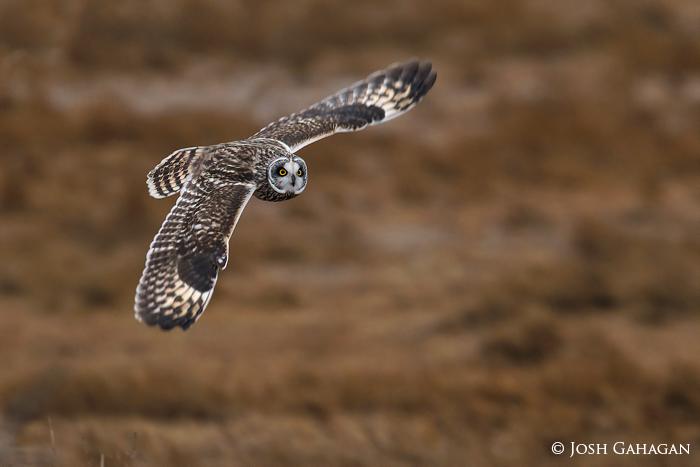MassWildlife’s Natural Heritage and Endangered Species Program conserves and protects the most vulnerable animal and plant species of Massachusetts and the habitats upon which they depend.
Description
Common name: Short-eared owl
Scientific name: Asio flammeus
Size: 13–17 inches long, 0.5–1.0 pounds
Range: North and South America, Europe, and Asia
MA Conservation status: Endangered
Federal conservation status: Not listed
Fun facts
- The short-eared owl is a striking medium sized owl with a white facial disk, yellow irises, and bold black patches around each eye.
- This species breeds in northern North America, from New England west to northern California and north to Alaska.
- Although fidelity to nesting sites has been documented between years, the species also can be semi-nomadic and use food abundance to identify nesting areas.
- It is an open country species and the only owl in Massachusetts that nests and roosts on the ground, hovers in flight, and frequently hunts during the day.
- Males perform a sky dance in their territory to attract females, and nesting begins in March-April.
- Incubation of eggs last approximately 30 days and chicks grow rapidly, dispersing from the nest around 15 days after hatching, with fledging (first flight) 24-35 days after hatching.
- Although there is limited data on survivorship for this species, the North American age record is 4 years, while in Europe it is 13 years for a wild bird.
Threats and conservation
- The short-eared owl requires large, undeveloped expanses of coastal sandplain grassland and maritime heathland for breeding and nesting. These habitats are under enormous pressure for development and are increasingly rare in Massachusetts. Since the 1980s, breeding of this species has declined precipitously in the Commonwealth. Wintering habitat includes both coastal areas as well as other areas or expansive grassland, including inland locations.
- The greatest threat facing short-eared owls in Massachusetts is habitat loss. The large, open, undisturbed areas where these endangered owls breed are under enormous pressure for development.
- Nest predation likely contributed to population declines of this species throughout New England, where it is now largely extirpated as a breeding bird.
- In the mid-1980s an estimated 20-25 pairs nested annually on the offshore islands of Massachusetts, but the most recent documented nesting pair was on Tuckernuck Island in 2010. There is some evidence they attempted to breed at the same site in 2014.
- In some years the short-eared owl still overwinters in areas of the state with suitable habitat; some may remain to nest in years when food resources are abundant.
- MassWildlife and partners continue to work towards protecting, restoring, and managing the coastal sandplain grassland and maritime heathland habitat that the short-eared owl requires for nesting in Massachusetts.
How you can help
- MassWildlife's Natural Heritage and Endangered Species Program (NHESP) is responsible for the conservation and protection of over 400 rare animals and plants, including the short-eared owl. NHESP's work is primarily funded through grants and donations from supportive citizens. Donate to NHESP today at mass.gov/supportnhesp
-
MassWildlife's Natural Heritage and Endangered Species Program is responsible for the conservation and protection of over 400 rare animals and plants, including short-eared owls. This work is primarily funded through grants and donations from supportive citizens. Support rare species conservation in Massachusetts—donate today!
